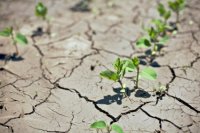Atmospher Sci & Global Chg
Research Highlights
September 2009
Rain, Rain Gone Away
Pollution in eastern China "reins in" light rain

Air pollution in eastern China has suppressed light rainfall by 23 percent over the past five decades, contributing to drought and decreased crop production. Enlarge Image
Results: Over the past 50 years, air pollution in eastern China has reduced the amount of light rainfall by 23 percent, a team led by a Pacific Northwest National Laboratory scientist has found. The results, published in the Journal of Geophysical Research, suggest that bad air quality may be contributing to severe droughts in parts of China, as well as causing health and environmental problems.
Why it matters: In the last half of the 20th century, sulfur emissions from fossil fuel burning in China increased by a factor of nine, dramatically reducing visibility. At the same time, the light rainfall that sustains crops decreased in eastern China, where most of the country's population lives. These changes made China a unique region to investigate the impact of aerosols on regional climate and the hydrological cycle. The study has increased the understanding of the role of pollution on light rainfall.
This research galvanized attention in the science community and news media worldwide. The journal article was ranked in the top five weekly downloaded papers in the Journal of Geophysical Research for weeks. News reporters covered it in the New York Times, LA Times, New Tang Dynasty TV, China Daily and Peoples' Daily Online, and many other outlets.
Methods: For the first time, using long-term data, researchers from the United States, China, and Sweden observed the connection of high levels of pollutants in the air with conditions that prevent the type of rainfall critical for agriculture. The team charted trends in rainfall from 1956 to 2005 in eastern China, which has 162 weather stations that provided complete data collected over the entire 50 years. Using this China Meteorological Administration data, the research team determined that both the north and south regions of eastern China had fewer days of light rain at the end of the 50-year time span. Light rain was defined as 10 millimeters per day or less.
The scientists found higher concentrations of cloud droplets when more aerosols (the tiny, unseen particles of gas, water, and bits of matter that makes up air pollution) were present. Aerosols create smaller water droplets, leading to less and smaller raindrops. The team verified this with computer models of pristine, moderately polluted or heavily polluted skies, by employing a cloud-resolving model known as the System for Atmospheric Modeling coupled with an explicit bin microphysics model to simulate aerosol effects on precipitation. Rain fell at significantly lower frequencies in the most heavily polluted simulation than in the pristine conditions.
The cloud droplet and raindrop sizes in polluted environments were up to 50 percent smaller than in the pristine environment. The smaller size impedes the formation of rain clouds and of light rain.
What's next: The team will examine new data, collected April to December 2008, from DOE's Atmospheric Radiation Measurement (ARM) Mobile Facility in the central eastern cities of Shouxian and Taihu in China. Past modeling studies of individual cases of pollution's effect on convective clouds have shown varying results, depending on the environmental conditions. The ARM data will provide more detailed measurements of both aerosols and clouds to assist the research team in quantifying the impacts of aerosols on precipitation under a variety of atmospheric and pollution conditions.
Acknowledgments: PNNL is transforming the nation's ability to transform climate change and its impacts. This research was sponsored by the U.S. Department of Energy's Office of Science, Biological and Environmental Research under a bilateral agreement with the China Ministry of Science and Technology on regional climate research.
Research Team: The research team included Drs. Yun Qian, Jiwen Fan, L. Ruby Leung, and Weiguo Wang from PNNL; Daoyi Gong, Beijing Normal University; Ralf Bennartz, University of Wisconsin; and Deliang Chen, University of Gothenburg.
Reference: Qian, Y., D. Gong, J. Fan, L. R. Leung, R. Bennartz, D. Chen, and W. Wang. August 2009. "Heavy pollution suppresses light rain in China: Observations and modeling." J. Geophys. Res., 114, D00K02, doi:10.1029/2008JD011575.
See PNNL's Press release.
